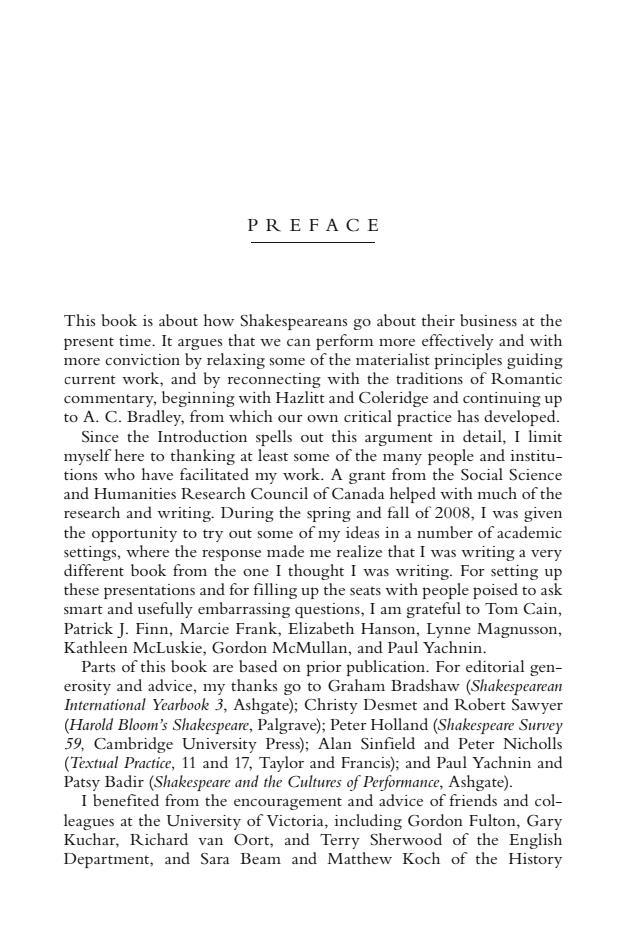正在加载图片...

PREFACE This book is about how Shakespeareans go about their business at the present time.It argues that we can perform more effectively and with more conviction by relaxing some of the materialist principles guiding current work,and by reconnecting with the traditions of Romantic commentary,beginning with Hazlitt and Coleridge and continuing up to A.C.Bradley,from which our own critical practice has developed. Since the Introduction spells out this argument in detail,I limit myself here to thanking at least some of the many people and institu- tions who have facilitated my work.A grant from the Social Science and Humanities Research Council of Canada helped with much of the research and writing.During the spring and fall of 2008,I was given the opportunity to try out some of my ideas in a number of academic settings,where the response made me realize that I was writing a very different book from the one I thought I was writing.For setting up these presentations and for filling up the seats with people poised to ask smart and usefully embarrassing questions,I am grateful to Tom Cain, Patrick J.Finn,Marcie Frank,Elizabeth Hanson,Lynne Magnusson, Kathleen McLuskie,Gordon McMullan,and Paul Yachnin. Parts of this book are based on prior publication.For editorial gen- erosity and advice,my thanks go to Graham Bradshaw (Shakespearean Interational Yearbook 3,Ashgate);Christy Desmet and Robert Sawyer (Harold Bloom's Shakespeare,Palgrave);Peter Holland(Shakespeare Survey 59,Cambridge University Press);Alan Sinfield and Peter Nicholls (Textual Practice,11 and 17,Taylor and Francis);and Paul Yachnin and Patsy Badir (Shakespeare and the Cultures of Performance,Ashgate). I benefited from the encouragement and advice of friends and col- leagues at the University of Victoria,including Gordon Fulton,Gary Kuchar,Richard van Oort,and Terry Sherwood of the English Department,and Sara Beam and Matthew Koch of the HistoryPREFACE This book is about how Shakespeareans go about their business at the present time. It argues that we can perform more effectively and with more conviction by relaxing some of the materialist principles guiding current work, and by reconnecting with the traditions of Romantic commentary, beginning with Hazlitt and Coleridge and continuing up to A. C. Bradley, from which our own critical practice has developed. Since the Introduction spells out this argument in detail, I limit myself here to thanking at least some of the many people and institutions who have facilitated my work. A grant from the Social Science and Humanities Research Council of Canada helped with much of the research and writing. During the spring and fall of 2008, I was given the opportunity to try out some of my ideas in a number of academic settings, where the response made me realize that I was writing a very different book from the one I thought I was writing. For setting up these presentations and for filling up the seats with people poised to ask smart and usefully embarrassing questions, I am grateful to Tom Cain, Patrick J. Finn, Marcie Frank, Elizabeth Hanson, Lynne Magnusson, Kathleen McLuskie, Gordon McMullan, and Paul Yachnin. Parts of this book are based on prior publication. For editorial generosity and advice, my thanks go to Graham Bradshaw (Shakespearean International Yearbook 3, Ashgate); Christy Desmet and Robert Sawyer (Harold Bloom’s Shakespeare, Palgrave); Peter Holland (Shakespeare Survey 59, Cambridge University Press); Alan Sinfield and Peter Nicholls (Textual Practice, 11 and 17, Taylor and Francis); and Paul Yachnin and Patsy Badir (Shakespeare and the Cultures of Performance, Ashgate). I benefited from the encouragement and advice of friends and colleagues at the University of Victoria, including Gordon Fulton, Gary Kuchar, Richard van Oort, and Terry Sherwood of the English Department, and Sara Beam and Matthew Koch of the History